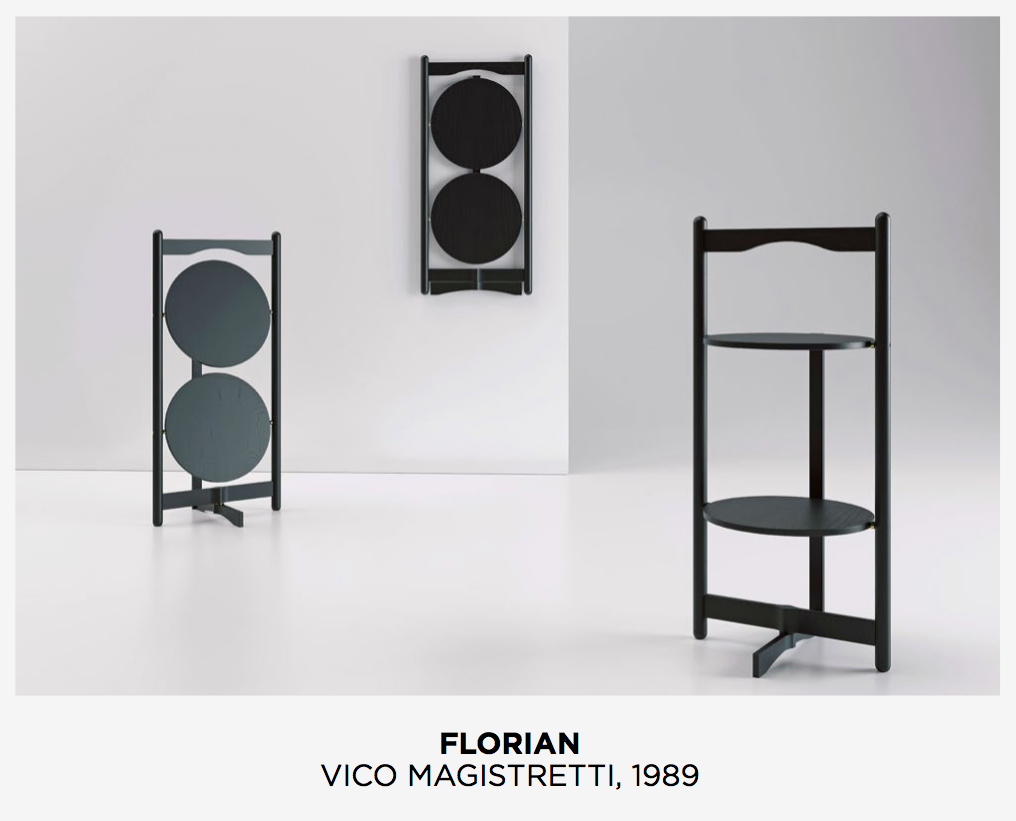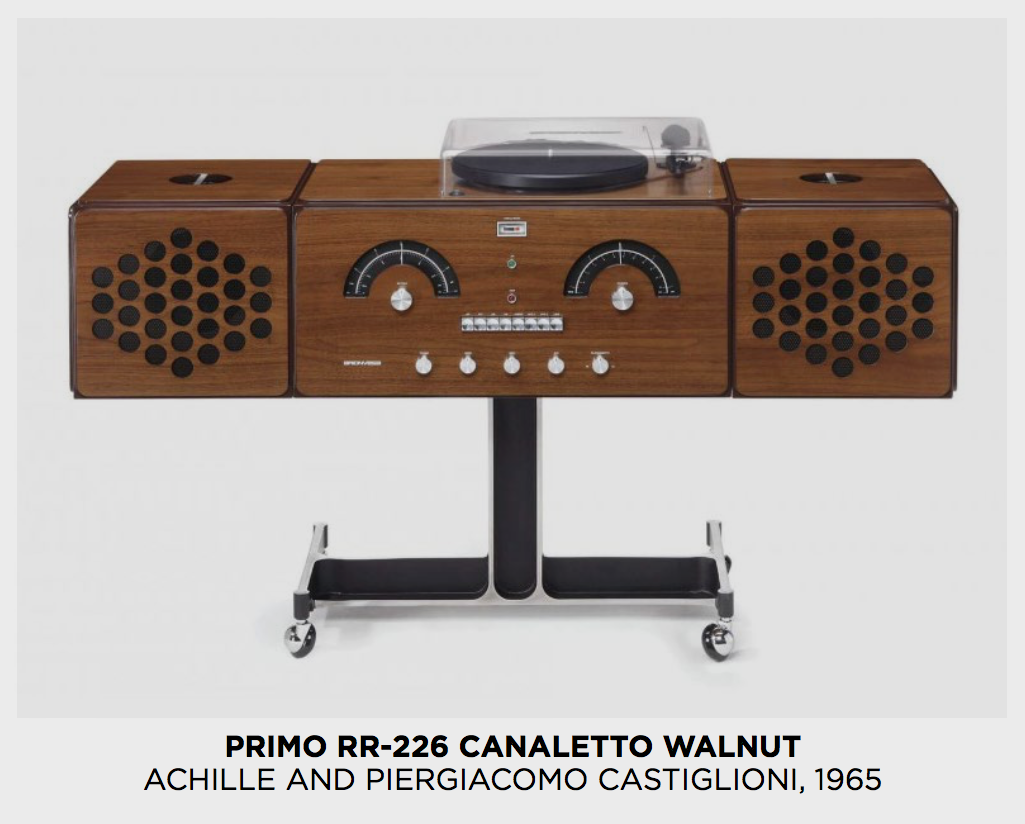In the globalised world of this early 21st Century, the digital revolution has disrupted the traditional ways knowledge is accessed and enjoyed, and turning back to the past is somehow reassuring and comforting. This might partly explain the success of the re-issues of some design pieces of the great masters of the past. The phenomenon is not to be dismissed as a simple fad nor a temporary one, for it has been going on for years and has been growing steadily.
Round armchair D.154.5
Gio Ponti, 1954

60 years after it was first issued, the iconic Round armchair (D.154.5) created by Gio Ponti in 1954 is brought to a new life in the context of the Heritage Collection, in collaboration with Ponti Archives.
Molteni&C’s re-edition project goes over its own design history with an eye to the future. The name of the project, Round D.154.4, takes after the rounded shape of the seat and backrest, dubbed the “bar of soap”. Thanks to a careful study of photos, drawings and other materials of the period, the armchair was faithfully reproduced, with a multilayered ash-wood frame, steel legs with black chrome and satin brass finishings, and non-slip plastic tips. the chair can be upholstered in any of the fabrics and leathers of the Molteni&C range. The new Round armchair was the star of the brand’s installation, curated by Ron Gilard, at the recent Salone del Mobile.
Orsola
Gastone Rinaldi, 1970

Roundness and comfort. Tradition and innovation. These are the keywords describing Orsola, a 1970 project by Gastone Rinaldi, re-issued today by Tacchini in its original spirit, but with latest-generation padding, supported by a rounded chrome-plated frame, giving it an, even more, relaxing and soft appearance. The three-seater sofa and the armchairs are handcrafted by upholstery masters, just like 50 years ago, but in a contemporary style.
Paolina
Ignazio Gardella, 1958

Designed in 1958 by Ignazio Gardella, the creative mind behind of some of Italy’s milestones of contemporary architecture, the Paolina suspension lamp is being re-issued by TATO as part of their research project around the works of the greatest Italian designers of the 20th Century. Born as a production piece, the lamp has a rounded, essential shape that seems to embrace the light source. In the updated version, the lamp features a shade made of polycarbonate, declined in a white or glossy green finishing, and a long-life LED light source.
For the ceiling mounting, the option is between a simple cable and a tubular element available in a brass, chrome, polished nickel or satin bronze finishing.
Soriana
Afra and Tobia Scarpa, 1969

A true icon of style with its generous, rounded shapes, it was designed in 1969 by visionary designers Afra and Tobia Scarpa. It won a Compasso d’Oro in 1970 and to-date it still is one of the most sought-after items for interior design projects worldwide.
Cassina, in collaboration with Tobia Scarpa, dug out from its archives what the designer defined as a “breath of irrenounceable relaxation”. Today Cassina is presenting a renewed version of Soriana in its declinations as an armchair, a chaise-longue, a two or three-seater sofa and a pouf. They all respect the original spirit and design to the letter, yet they employ sustainable materials in line with the new lifestyle trends. Extra comfort is ensured thanks to the work of Cassina LAB, born out of the collaboration between Cassina’s own R&D center and Poli design from Milan’s Polytechnic.
Tip Ton RE
Edward Barber and Jay Osgerby, 2011

Created by designers Edward Barber e Jay Osgerby, Tip Ton defines a totally new kind of seat: a chair entirely made of plastic that can be tipped forward at a slight angle with respect to its normal position, hence the name Tip Ton. The inclination straightens up your hips and lower spine, improving the blood circulation in your back and abdominal muscles. In 2020, together with Vitra, the designers developed a recycled polypropylene version: Tip Ton RE. The high-quality recycled materials derive from domestic waste, in particular packaging.
Both models are produced out of a single cast that doesn’t have any mechanical parts, a solution that makes them extremely strong and 100% recyclable. The chairs can be stacked in piles of up to four units. Tip Ton RE is available in grey only.
Polet
Achille Castiglioni, 1992

On the occasion of Fuori Salone 2021, Polet was introduced as a re-issue of the armchair-bed system designed by Achille Castiglioni for Twils in the early 90s. Conceived as a futuristic project, today it is an icon of style and functionality, and 30 years on it can still disrupt the contemporary idea of multi-functional furnishing, without sacrificing style in favour of comfort and ease of use.
Polet stands out for its assertive, straightforward style and for its rectangular, black-lacquered solid beechwood structure also featuring a brass joint. The thin quilted mattress made of brightly coloured fabrics is an ideal feature for creative and stylish interpretations.
Polet can be used as a chair, a lounge chair or a bed in four different configurations: armchair, bed, reading/working recliner and chaise-longue.
Bul-Bo Soft
Roberto Gabetti, Aimaro Isola, Guido Drocco and Luciano Re, 1968-1971

Bul-bo is an iconic floor lamp, created between 1968 and1971 by Roberto Gabetti, Aimaro Isola, Guido Drocco and Luciano Re for Olivetti’s residential estate in Ivrea. It was recently re-issued by Axolight with the introduction of contemporary elements, yet respecting the spirit of the original design. It owes its name to its particular stand, in the shape of a bulb. The new edition kept this original feature, with a bulb made of faux-leather and filled up with 25 kg of stone gravel, acting as both a counterweight and support for the aluminium stalk ending in the light-bulb shaped metal lamp.
Bul-bo was born as an ironic and playful object, a distinctive trait of all the furniture at the Olivetti Residential Center, standing out for its totally innovative design.
The new Bul-Bo Soft was presented at the Salone del Mobile as a colourful and cushy interpretation in the Altai fabric by Loro Piana Interiors. The stand is lined with a two-colours wool-and-cashmere fabric, with contrasting warm-red stitching.
Mercury
Rito Valla, 1961

The Mercury armchair and sofa, designed by sculptor Rito Valla in 1961, were originally launched at the first edition of the Salone del Mobile in Milano by IPE, a brand founded in 1959 that gained immediate notoriety thanks to its innovative use of polyurethane foam in furniture. Today, they’re back in a limited edition by Visionnaire, a 2004 IPE spin-off.
The re-edition of this soft, curvy set is a tribute to IPE’s legacy, emphasising the original design: the plum, welcoming shapes obtained through the use of latest-generation foams, are modelled around a metallic mesh light frame that gives the objects an aura of timeless elegance. The 5-spoke circular stand, made of wood and steel, further contributes to the unique personality to the products.
Camaleonda
Dario Bellini, 1970

The re-edition of the sofa designed by Dario Bellini for B&B Italia five decades ago is entirely respectful of the original project. Form, dimensions and use are the same as those imagined by the designer in 1970, though the padding has been re-thought by B&B’s R&D center that came up with a polyurethane sandwich structure producing a pleasant spring effect. It is very easy to disassemble and therefore to recycle.
The name Camaleonda is a neologism created by Bellini to describe the form and function of the chair, which stands out for its boundless modularity and the geometry of its components. Elements can be combined and recombined endless times according to taste and needs thanks to a system of connecting rods and loops.
Minitopo
Joe Colombo, 1970

Fifty years after its original launch, Stilnovo is re-issuing Minitopo, the lamp created by Joe Colombo in 1970 and inspired by Topo, the lamp he designed specifically for drawing boards. The name ironically takes after the rounded shape of the lampshade, reminiscent of a mouse. The switch resembles a cute nose, while the top handle, used to point the lamp in the desired direction, represents the ears. The stand, a curved tubular stem ending in a rounded base from where the lamp is grabbed to be moved around, corresponds to the tail.
Florian
Vico Magistretti, 1989

Originally designed by Vico Magistretti in 1989, Florian is one of the new 2021 projects originating from the Acerbis archives and presented at the Salone del Mobile.
Ingenuously functional, Florian embodies Magistretti’s extraordinary knack for simplicity: a light table featuring multiple levels, built on a folding structure inspired by a broomstick. By a simple mechanism in the central stem, the whole table folds up completely and can be hung on the wall, where it turns into a decorative element made of circles and lines.
In the Francesco Meda and David Lopez Quincoces’ version, Florian’s dimensions are adapted to modern life, and its ash-wood structure swiftly and softly bends thanks to an innovative brass mechanism. Its visual impact is enhanced by the lacquered mustard, pine green and brick red finish.
Primo rr-226 Canaletto Walnut
Achille and Piergiacomo Castiglioni, 1965

A must-have collectable, PRIMO is the radiogram imagined by the Castiglioni brothers in 1965. It is being re-issued today in a 100 units limited series as a tribute to art and industrial design in general but also to one of the most iconic pieces of BRIONVEGA, capable of “furnishing with music” the most exclusive locations around the planet.
The walnut wood it is made of confers it a particularly premium allure. Great attention was paid during assembly so that the wood grain would perfectly combine with the marks of
the hand flaming to form natural and mesmerising patterns. Its playful musical-robot aspect turns it into a friendly object, capable of bringing humans closer to technology.
If you want to learn more about our design philoophy in making our beautifully-crafted appliances, pleace click here.
Copyright HOMA 2022- Issued By Homa Marketing dept. on March 2022

.jpg?VGhlIFBlcmZlY3QgU2xvdC1pbijmraPnoa4pLmpwZw==)












.jpg?MTkyMHg3MjDvvIhkZXPvvIkuanBn)
.jpg?MTAyNHg3NDDvvIhkZXPvvIkuanBn)



















